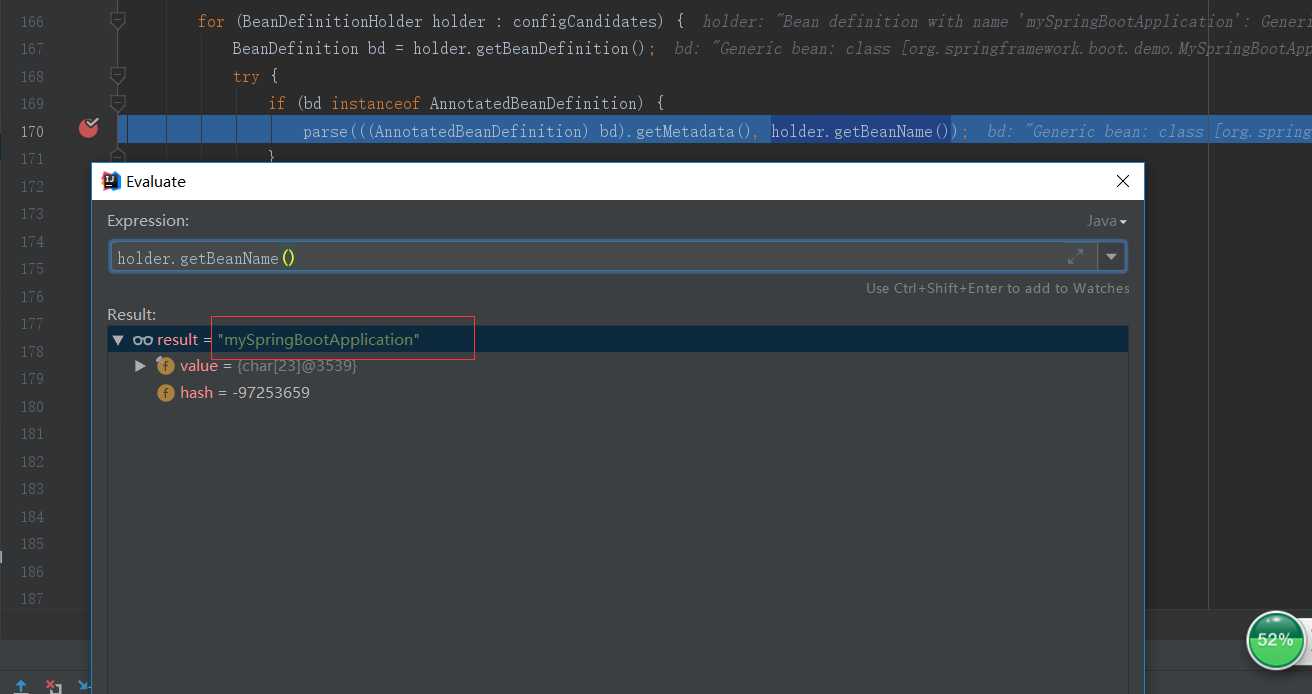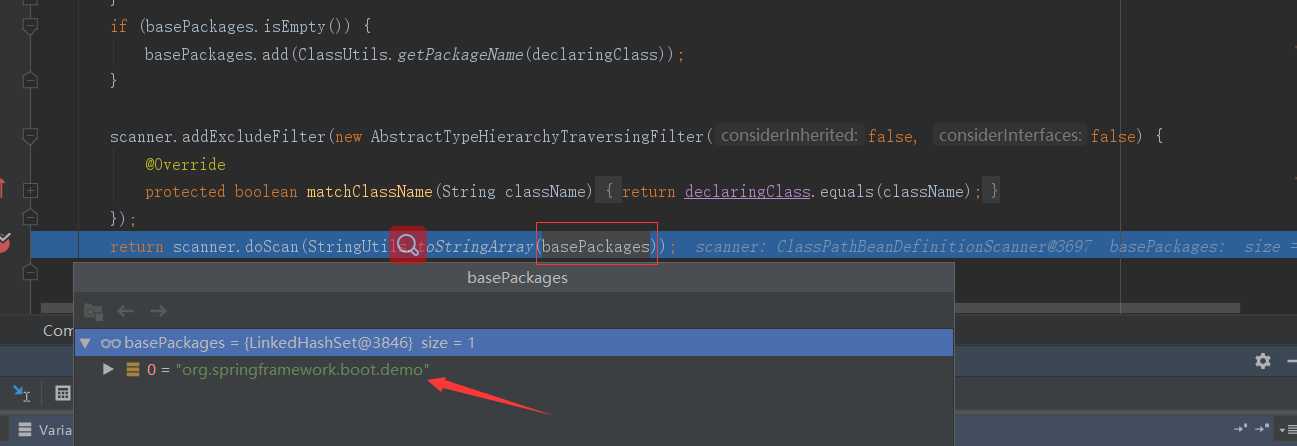标签:crete fresh cal rem eof ram throw message one
SpringBoot系列文章简介
SpringBoot源码阅读辅助篇:
SpringBoot启动流程源码分析:
笔者注释版Spring Framework与SpringBoot源码git传送门:请不要吝啬小星星
第五步:刷新应用上下文
在前面的博客中谈到IoC容器的初始化过程,主要分下面三步:
1 BeanDefinition的Resource定位 2 BeanDefinition的载入 3 向IoC容器注册BeanDefinition
在上一篇文章介绍了prepareContext()方法,在准备刷新阶段做了什么工作。本文我们主要从refresh()方法中总结IoC容器的初始化过程。
从run方法的,refreshContext()方法一路跟下去,最终来到AbstractApplicationContext类的refresh()方法。
1 @Override 2 public void refresh() throws BeansException, IllegalStateException { 3 synchronized (this.startupShutdownMonitor) { 4 // Prepare this context for refreshing. 5 //刷新上下文环境 6 prepareRefresh(); 7 // Tell the subclass to refresh the internal bean factory. 8 //这里是在子类中启动 refreshBeanFactory() 的地方 9 ConfigurableListableBeanFactory beanFactory = obtainFreshBeanFactory(); 10 // Prepare the bean factory for use in this context. 11 //准备bean工厂,以便在此上下文中使用 12 prepareBeanFactory(beanFactory); 13 try { 14 // Allows post-processing of the bean factory in context subclasses. 15 //设置 beanFactory 的后置处理 16 postProcessBeanFactory(beanFactory); 17 // Invoke factory processors registered as beans in the context. 18 //调用 BeanFactory 的后处理器,这些处理器是在Bean 定义中向容器注册的 19 invokeBeanFactoryPostProcessors(beanFactory); 20 // Register bean processors that intercept bean creation. 21 //注册Bean的后处理器,在Bean创建过程中调用 22 registerBeanPostProcessors(beanFactory); 23 // Initialize message source for this context. 24 //对上下文中的消息源进行初始化 25 initMessageSource(); 26 // Initialize event multicaster for this context. 27 //初始化上下文中的事件机制 28 initApplicationEventMulticaster(); 29 // Initialize other special beans in specific context subclasses. 30 //初始化其他特殊的Bean 31 onRefresh(); 32 // Check for listener beans and register them. 33 //检查监听Bean并且将这些监听Bean向容器注册 34 registerListeners(); 35 // Instantiate all remaining (non-lazy-init) singletons. 36 //实例化所有的(non-lazy-init)单件 37 finishBeanFactoryInitialization(beanFactory); 38 // Last step: publish corresponding event. 39 //发布容器事件,结束Refresh过程 40 finishRefresh(); 41 } catch (BeansException ex) { 42 if (logger.isWarnEnabled()) { 43 logger.warn("Exception encountered during context initialization - " + 44 "cancelling refresh attempt: " + ex); 45 } 46 // Destroy already created singletons to avoid dangling resources. 47 destroyBeans(); 48 // Reset ‘active‘ flag. 49 cancelRefresh(ex); 50 // Propagate exception to caller. 51 throw ex; 52 } finally { 53 // Reset common introspection caches in Spring‘s core, since we 54 // might not ever need metadata for singleton beans anymore... 55 resetCommonCaches(); 56 } 57 } 58 }
从以上代码中我们可以看到,refresh()方法中所作的工作也挺多,我们没办法面面俱到,主要根据IoC容器的初始化步骤和IoC依赖注入的过程进行分析,围绕以上两个过程,我们主要介绍重要的方法,其他的请看注释。
在启动流程的第三步:初始化应用上下文。中我们创建了应用的上下文,并触发了GenericApplicationContext类的构造方法如下所示,创建了beanFactory,也就是创建了DefaultListableBeanFactory类。
1 public GenericApplicationContext() { 2 this.beanFactory = new DefaultListableBeanFactory(); 3 }
关于obtainFreshBeanFactory()方法,其实就是拿到我们之前创建的beanFactory。
1 protected ConfigurableListableBeanFactory obtainFreshBeanFactory() { 2 //刷新BeanFactory 3 refreshBeanFactory(); 4 //获取beanFactory 5 ConfigurableListableBeanFactory beanFactory = getBeanFactory(); 6 if (logger.isDebugEnabled()) { 7 logger.debug("Bean factory for " + getDisplayName() + ": " + beanFactory); 8 } 9 return beanFactory; 10 }
从上面代码可知,在该方法中主要做了三个工作,刷新beanFactory,获取beanFactory,返回beanFactory。
首先看一下refreshBeanFactory()方法,跟下去来到GenericApplicationContext类的refreshBeanFactory()发现也没做什么。
1 @Override 2 protected final void refreshBeanFactory() throws IllegalStateException { 3 if (!this.refreshed.compareAndSet(false, true)) { 4 throw new IllegalStateException( 5 "GenericApplicationContext does not support multiple refresh attempts: just call ‘refresh‘ once"); 6 } 7 this.beanFactory.setSerializationId(getId()); 8 }
TIPS: 1,AbstractApplicationContext类有两个子类实现了refreshBeanFactory(),但是在前面第三步初始化上下文的时候, 实例化了GenericApplicationContext类,所以没有进入AbstractRefreshableApplicationContext中的refreshBeanFactory()方法。 2,this.refreshed.compareAndSet(false, true) 这行代码在这里表示:GenericApplicationContext只允许刷新一次 这行代码,很重要,不是在Spring中很重要,而是这行代码本身。首先看一下this.refreshed属性: private final AtomicBoolean refreshed = new AtomicBoolean(); java J.U.C并发包中很重要的一个原子类AtomicBoolean。通过该类的compareAndSet()方法可以实现一段代码绝对只实现一次的功能。 感兴趣的自行百度吧。

从字面意思上可以看出准备BeanFactory。
看代码,具体看看做了哪些准备工作。这个方法不是重点,看注释吧。
1 protected void prepareBeanFactory(ConfigurableListableBeanFactory beanFactory) { 2 // Tell the internal bean factory to use the context‘s class loader etc. 3 // 配置类加载器:默认使用当前上下文的类加载器 4 beanFactory.setBeanClassLoader(getClassLoader()); 5 // 配置EL表达式:在Bean初始化完成,填充属性的时候会用到 6 beanFactory.setBeanExpressionResolver(new StandardBeanExpressionResolver(beanFactory.getBeanClassLoader())); 7 // 添加属性编辑器 PropertyEditor 8 beanFactory.addPropertyEditorRegistrar(new ResourceEditorRegistrar(this, getEnvironment())); 9 10 // Configure the bean factory with context callbacks. 11 // 添加Bean的后置处理器 12 beanFactory.addBeanPostProcessor(new ApplicationContextAwareProcessor(this)); 13 // 忽略装配以下指定的类 14 beanFactory.ignoreDependencyInterface(EnvironmentAware.class); 15 beanFactory.ignoreDependencyInterface(EmbeddedValueResolverAware.class); 16 beanFactory.ignoreDependencyInterface(ResourceLoaderAware.class); 17 beanFactory.ignoreDependencyInterface(ApplicationEventPublisherAware.class); 18 beanFactory.ignoreDependencyInterface(MessageSourceAware.class); 19 beanFactory.ignoreDependencyInterface(ApplicationContextAware.class); 20 21 // BeanFactory interface not registered as resolvable type in a plain factory. 22 // MessageSource registered (and found for autowiring) as a bean. 23 // 将以下类注册到 beanFactory(DefaultListableBeanFactory) 的resolvableDependencies属性中 24 beanFactory.registerResolvableDependency(BeanFactory.class, beanFactory); 25 beanFactory.registerResolvableDependency(ResourceLoader.class, this); 26 beanFactory.registerResolvableDependency(ApplicationEventPublisher.class, this); 27 beanFactory.registerResolvableDependency(ApplicationContext.class, this); 28 29 // Register early post-processor for detecting inner beans as ApplicationListeners. 30 // 将早期后处理器注册为application监听器,用于检测内部bean 31 beanFactory.addBeanPostProcessor(new ApplicationListenerDetector(this)); 32 33 // Detect a LoadTimeWeaver and prepare for weaving, if found. 34 //如果当前BeanFactory包含loadTimeWeaver Bean,说明存在类加载期织入AspectJ, 35 // 则把当前BeanFactory交给类加载期BeanPostProcessor实现类LoadTimeWeaverAwareProcessor来处理, 36 // 从而实现类加载期织入AspectJ的目的。 37 if (beanFactory.containsBean(LOAD_TIME_WEAVER_BEAN_NAME)) { 38 beanFactory.addBeanPostProcessor(new LoadTimeWeaverAwareProcessor(beanFactory)); 39 // Set a temporary ClassLoader for type matching. 40 beanFactory.setTempClassLoader(new ContextTypeMatchClassLoader(beanFactory.getBeanClassLoader())); 41 } 42 43 // Register default environment beans. 44 // 将当前环境变量(environment) 注册为单例bean 45 if (!beanFactory.containsLocalBean(ENVIRONMENT_BEAN_NAME)) { 46 beanFactory.registerSingleton(ENVIRONMENT_BEAN_NAME, getEnvironment()); 47 } 48 // 将当前系统配置(systemProperties) 注册为单例Bean 49 if (!beanFactory.containsLocalBean(SYSTEM_PROPERTIES_BEAN_NAME)) { 50 beanFactory.registerSingleton(SYSTEM_PROPERTIES_BEAN_NAME, getEnvironment().getSystemProperties()); 51 } 52 // 将当前系统环境 (systemEnvironment) 注册为单例Bean 53 if (!beanFactory.containsLocalBean(SYSTEM_ENVIRONMENT_BEAN_NAME)) { 54 beanFactory.registerSingleton(SYSTEM_ENVIRONMENT_BEAN_NAME, getEnvironment().getSystemEnvironment()); 55 } 56 }
postProcessBeanFactory()方法向上下文中添加了一系列的Bean的后置处理器。后置处理器工作的时机是在所有的beanDenifition加载完成之后,bean实例化之前执行。简单来说Bean的后置处理器可以修改BeanDefinition的属性信息。
关于这个方法就先这样吧,有兴趣的可以直接百度该方法。篇幅有限,对该方法不做过多介绍。
上面说过,IoC容器的初始化过程包括三个步骤,在invokeBeanFactoryPostProcessors()方法中完成了IoC容器初始化过程的三个步骤。
1,第一步:Resource定位
在SpringBoot中,我们都知道他的包扫描是从主类所在的包开始扫描的,prepareContext()方法中,会先将主类解析成BeanDefinition,然后在refresh()方法的invokeBeanFactoryPostProcessors()方法中解析主类的BeanDefinition获取basePackage的路径。这样就完成了定位的过程。其次SpringBoot的各种starter是通过SPI扩展机制实现的自动装配,SpringBoot的自动装配同样也是在invokeBeanFactoryPostProcessors()方法中实现的。还有一种情况,在SpringBoot中有很多的@EnableXXX注解,细心点进去看的应该就知道其底层是@Import注解,在invokeBeanFactoryPostProcessors()方法中也实现了对该注解指定的配置类的定位加载。
常规的在SpringBoot中有三种实现定位,第一个是主类所在包的,第二个是SPI扩展机制实现的自动装配(比如各种starter),第三种就是@Import注解指定的类。(对于非常规的不说了)
2,第二步:BeanDefinition的载入
在第一步中说了三种Resource的定位情况,定位后紧接着就是BeanDefinition的分别载入。所谓的载入就是通过上面的定位得到的basePackage,SpringBoot会将该路径拼接成:classpath*:org/springframework/boot/demo/**/*.class这样的形式,然后一个叫做PathMatchingResourcePatternResolver的类会将该路径下所有的.class文件都加载进来,然后遍历判断是不是有@Component注解,如果有的话,就是我们要装载的BeanDefinition。大致过程就是这样的了。
TIPS:
@Configuration,@Controller,@Service等注解底层都是@Component注解,只不过包装了一层罢了。
3、第三个过程:注册BeanDefinition
这个过程通过调用上文提到的BeanDefinitionRegister接口的实现来完成。这个注册过程把载入过程中解析得到的BeanDefinition向IoC容器进行注册。通过上文的分析,我们可以看到,在IoC容器中将BeanDefinition注入到一个ConcurrentHashMap中,IoC容器就是通过这个HashMap来持有这些BeanDefinition数据的。比如DefaultListableBeanFactory 中的beanDefinitionMap属性。
OK,总结完了,接下来我们通过代码看看具体是怎么实现的。
1 protected void invokeBeanFactoryPostProcessors(ConfigurableListableBeanFactory beanFactory) { 2 PostProcessorRegistrationDelegate.invokeBeanFactoryPostProcessors(beanFactory, getBeanFactoryPostProcessors()); 3 ... 4 } 5 // PostProcessorRegistrationDelegate类 6 public static void invokeBeanFactoryPostProcessors( 7 ConfigurableListableBeanFactory beanFactory, List<BeanFactoryPostProcessor> beanFactoryPostProcessors) { 8 ... 9 invokeBeanDefinitionRegistryPostProcessors(currentRegistryProcessors, registry); 10 ... 11 } 12 // PostProcessorRegistrationDelegate类 13 private static void invokeBeanDefinitionRegistryPostProcessors( 14 Collection<? extends BeanDefinitionRegistryPostProcessor> postProcessors, BeanDefinitionRegistry registry) { 15 16 for (BeanDefinitionRegistryPostProcessor postProcessor : postProcessors) { 17 postProcessor.postProcessBeanDefinitionRegistry(registry); 18 } 19 } 20 // ConfigurationClassPostProcessor类 21 @Override 22 public void postProcessBeanDefinitionRegistry(BeanDefinitionRegistry registry) { 23 ... 24 processConfigBeanDefinitions(registry); 25 } 26 // ConfigurationClassPostProcessor类 27 public void processConfigBeanDefinitions(BeanDefinitionRegistry registry) { 28 ... 29 do { 30 parser.parse(candidates); 31 parser.validate(); 32 ... 33 } 34 ... 35 }
一路跟踪调用栈,来到ConfigurationClassParser类的parse()方法。
1 // ConfigurationClassParser类 2 public void parse(Set<BeanDefinitionHolder> configCandidates) { 3 this.deferredImportSelectors = new LinkedList<>(); 4 for (BeanDefinitionHolder holder : configCandidates) { 5 BeanDefinition bd = holder.getBeanDefinition(); 6 try { 7 // 如果是SpringBoot项目进来的,bd其实就是前面主类封装成的 AnnotatedGenericBeanDefinition(AnnotatedBeanDefinition接口的实现类) 8 if (bd instanceof AnnotatedBeanDefinition) { 9 parse(((AnnotatedBeanDefinition) bd).getMetadata(), holder.getBeanName()); 10 } else if (bd instanceof AbstractBeanDefinition && ((AbstractBeanDefinition) bd).hasBeanClass()) { 11 parse(((AbstractBeanDefinition) bd).getBeanClass(), holder.getBeanName()); 12 } else { 13 parse(bd.getBeanClassName(), holder.getBeanName()); 14 } 15 } catch (BeanDefinitionStoreException ex) { 16 throw ex; 17 } catch (Throwable ex) { 18 throw new BeanDefinitionStoreException( 19 "Failed to parse configuration class [" + bd.getBeanClassName() + "]", ex); 20 } 21 } 22 // 加载默认的配置---》(对springboot项目来说这里就是自动装配的入口了) 23 processDeferredImportSelectors(); 24 }
看上面的注释,在前面的prepareContext()方法中,我们详细介绍了我们的主类是如何一步步的封装成AnnotatedGenericBeanDefinition,并注册进IoC容器的beanDefinitionMap中的。
TIPS: 至于processDeferredImportSelectors();方法,后面我们分析SpringBoot的自动装配的时候会详细讲解,各种starter是如何一步步的实现自动装配的。<SpringBoot启动流程分析(五):SpringBoot自动装配原理实现>

继续沿着parse(((AnnotatedBeanDefinition) bd).getMetadata(), holder.getBeanName());方法跟下去
1 // ConfigurationClassParser类 2 protected final void parse(AnnotationMetadata metadata, String beanName) throws IOException { 3 processConfigurationClass(new ConfigurationClass(metadata, beanName)); 4 } 5 // ConfigurationClassParser类 6 protected void processConfigurationClass(ConfigurationClass configClass) throws IOException { 7 ... 8 // Recursively process the configuration class and its superclass hierarchy. 9 //递归地处理配置类及其父类层次结构。 10 SourceClass sourceClass = asSourceClass(configClass); 11 do { 12 //递归处理Bean,如果有父类,递归处理,直到顶层父类 13 sourceClass = doProcessConfigurationClass(configClass, sourceClass); 14 } 15 while (sourceClass != null); 16 17 this.configurationClasses.put(configClass, configClass); 18 } 19 // ConfigurationClassParser类 20 protected final SourceClass doProcessConfigurationClass(ConfigurationClass configClass, SourceClass sourceClass) 21 throws IOException { 22 23 // Recursively process any member (nested) classes first 24 //首先递归处理内部类,(SpringBoot项目的主类一般没有内部类) 25 processMemberClasses(configClass, sourceClass); 26 27 // Process any @PropertySource annotations 28 // 针对 @PropertySource 注解的属性配置处理 29 for (AnnotationAttributes propertySource : AnnotationConfigUtils.attributesForRepeatable( 30 sourceClass.getMetadata(), PropertySources.class, 31 org.springframework.context.annotation.PropertySource.class)) { 32 if (this.environment instanceof ConfigurableEnvironment) { 33 processPropertySource(propertySource); 34 } else { 35 logger.warn("Ignoring @PropertySource annotation on [" + sourceClass.getMetadata().getClassName() + 36 "]. Reason: Environment must implement ConfigurableEnvironment"); 37 } 38 } 39 40 // Process any @ComponentScan annotations 41 // 根据 @ComponentScan 注解,扫描项目中的Bean(SpringBoot 启动类上有该注解) 42 Set<AnnotationAttributes> componentScans = AnnotationConfigUtils.attributesForRepeatable( 43 sourceClass.getMetadata(), ComponentScans.class, ComponentScan.class); 44 if (!componentScans.isEmpty() && 45 !this.conditionEvaluator.shouldSkip(sourceClass.getMetadata(), ConfigurationPhase.REGISTER_BEAN)) { 46 for (AnnotationAttributes componentScan : componentScans) { 47 // The config class is annotated with @ComponentScan -> perform the scan immediately 48 // 立即执行扫描,(SpringBoot项目为什么是从主类所在的包扫描,这就是关键了) 49 Set<BeanDefinitionHolder> scannedBeanDefinitions = 50 this.componentScanParser.parse(componentScan, sourceClass.getMetadata().getClassName()); 51 // Check the set of scanned definitions for any further config classes and parse recursively if needed 52 for (BeanDefinitionHolder holder : scannedBeanDefinitions) { 53 BeanDefinition bdCand = holder.getBeanDefinition().getOriginatingBeanDefinition(); 54 if (bdCand == null) { 55 bdCand = holder.getBeanDefinition(); 56 } 57 // 检查是否是ConfigurationClass(是否有configuration/component两个注解),如果是,递归查找该类相关联的配置类。 58 // 所谓相关的配置类,比如@Configuration中的@Bean定义的bean。或者在有@Component注解的类上继续存在@Import注解。 59 if (ConfigurationClassUtils.checkConfigurationClassCandidate(bdCand, this.metadataReaderFactory)) { 60 parse(bdCand.getBeanClassName(), holder.getBeanName()); 61 } 62 } 63 } 64 } 65 66 // Process any @Import annotations 67 //递归处理 @Import 注解(SpringBoot项目中经常用的各种@Enable*** 注解基本都是封装的@Import) 68 processImports(configClass, sourceClass, getImports(sourceClass), true); 69 70 // Process any @ImportResource annotations 71 AnnotationAttributes importResource = 72 AnnotationConfigUtils.attributesFor(sourceClass.getMetadata(), ImportResource.class); 73 if (importResource != null) { 74 String[] resources = importResource.getStringArray("locations"); 75 Class<? extends BeanDefinitionReader> readerClass = importResource.getClass("reader"); 76 for (String resource : resources) { 77 String resolvedResource = this.environment.resolveRequiredPlaceholders(resource); 78 configClass.addImportedResource(resolvedResource, readerClass); 79 } 80 } 81 82 // Process individual @Bean methods 83 Set<MethodMetadata> beanMethods = retrieveBeanMethodMetadata(sourceClass); 84 for (MethodMetadata methodMetadata : beanMethods) { 85 configClass.addBeanMethod(new BeanMethod(methodMetadata, configClass)); 86 } 87 88 // Process default methods on interfaces 89 processInterfaces(configClass, sourceClass); 90 91 // Process superclass, if any 92 if (sourceClass.getMetadata().hasSuperClass()) { 93 String superclass = sourceClass.getMetadata().getSuperClassName(); 94 if (superclass != null && !superclass.startsWith("java") && 95 !this.knownSuperclasses.containsKey(superclass)) { 96 this.knownSuperclasses.put(superclass, configClass); 97 // Superclass found, return its annotation metadata and recurse 98 return sourceClass.getSuperClass(); 99 } 100 } 101 102 // No superclass -> processing is complete 103 return null; 104 }
看doProcessConfigurationClass()方法。(SpringBoot的包扫描的入口方法,重点哦)
我们先大致说一下这个方法里面都干了什么,然后稍后再阅读源码分析。
TIPS: 在以上代码的第60行parse(bdCand.getBeanClassName(), holder.getBeanName());会进行递归调用, 因为当Spring扫描到需要加载的类会进一步判断每一个类是否满足是@Component/@Configuration注解的类, 如果满足会递归调用parse()方法,查找其相关的类。 同样的第68行processImports(configClass, sourceClass, getImports(sourceClass), true); 通过@Import注解查找到的类同样也会递归查找其相关的类。 两个递归在debug的时候会很乱,用文字叙述起来更让人难以理解,所以,我们只关注对主类的解析,及其类的扫描过程。
上面代码的第29行 for (AnnotationAttributes propertySource : AnnotationConfigUtils.attributesForRepeatable(... 获取主类上的@PropertySource注解(关于该注解是怎么用的请自行百度),解析该注解并将该注解指定的properties配置文件中的值存储到Spring的 Environment中,Environment接口提供方法去读取配置文件中的值,参数是properties文件中定义的key值。
42行 Set<AnnotationAttributes> componentScans = AnnotationConfigUtils.attributesForRepeatable( sourceClass.getMetadata(), ComponentScans.class, ComponentScan.class); 解析主类上的@ComponentScan注解,呃,怎么说呢,42行后面的代码将会解析该注解并进行包扫描。
68行 processImports(configClass, sourceClass, getImports(sourceClass), true); 解析主类上的@Import注解,并加载该注解指定的配置类。
TIPS:
在spring中好多注解都是一层一层封装的,比如@EnableXXX,是对@Import注解的二次封装。@SpringBootApplication注解=@ComponentScan+@EnableAutoConfiguration+@Import+@Configuration+@Component。@Controller,@Service等等是对@Component的二次封装。。。
从上面的42行往下看,来到第49行 Set<BeanDefinitionHolder> scannedBeanDefinitions = this.componentScanParser.parse(componentScan, sourceClass.getMetadata().getClassName());
进入该方法
1 // ComponentScanAnnotationParser类 2 public Set<BeanDefinitionHolder> parse(AnnotationAttributes componentScan, final String declaringClass) { 3 ClassPathBeanDefinitionScanner scanner = new ClassPathBeanDefinitionScanner(this.registry, 4 componentScan.getBoolean("useDefaultFilters"), this.environment, this.resourceLoader); 5 ... 6 // 根据 declaringClass (如果是SpringBoot项目,则参数为主类的全路径名) 7 if (basePackages.isEmpty()) { 8 basePackages.add(ClassUtils.getPackageName(declaringClass)); 9 } 10 ... 11 // 根据basePackages扫描类 12 return scanner.doScan(StringUtils.toStringArray(basePackages)); 13 }
发现有两行重要的代码
为了验证代码中的注释,debug,看一下declaringClass,如下图所示确实是我们的主类的全路径名。

跳过这一行,继续debug,查看basePackages,该set集合中只有一个,就是主类所在的路径。
TIPS:
为什么只有一个还要用一个集合呢,因为我们也可以用@ComponentScan注解指定扫描路径。

到这里呢IoC容器初始化三个步骤的第一步,Resource定位就完成了,成功定位到了主类所在的包。
接着往下看 return scanner.doScan(StringUtils.toStringArray(basePackages)); Spring是如何进行类扫描的。进入doScan()方法。
1 // ComponentScanAnnotationParser类 2 protected Set<BeanDefinitionHolder> doScan(String... basePackages) { 3 Assert.notEmpty(basePackages, "At least one base package must be specified"); 4 Set<BeanDefinitionHolder> beanDefinitions = new LinkedHashSet<>(); 5 for (String basePackage : basePackages) { 6 // 从指定的包中扫描需要装载的Bean 7 Set<BeanDefinition> candidates = findCandidateComponents(basePackage); 8 for (BeanDefinition candidate : candidates) { 9 ScopeMetadata scopeMetadata = this.scopeMetadataResolver.resolveScopeMetadata(candidate); 10 candidate.setScope(scopeMetadata.getScopeName()); 11 String beanName = this.beanNameGenerator.generateBeanName(candidate, this.registry); 12 if (candidate instanceof AbstractBeanDefinition) { 13 postProcessBeanDefinition((AbstractBeanDefinition) candidate, beanName); 14 } 15 if (candidate instanceof AnnotatedBeanDefinition) { 16 AnnotationConfigUtils.processCommonDefinitionAnnotations((AnnotatedBeanDefinition) candidate); 17 } 18 if (checkCandidate(beanName, candidate)) { 19 BeanDefinitionHolder definitionHolder = new BeanDefinitionHolder(candidate, beanName); 20 definitionHolder = 21 AnnotationConfigUtils.applyScopedProxyMode(scopeMetadata, definitionHolder, this.registry); 22 beanDefinitions.add(definitionHolder); 23 //将该 Bean 注册进 IoC容器(beanDefinitionMap) 24 registerBeanDefinition(definitionHolder, this.registry); 25 } 26 } 27 } 28 return beanDefinitions; 29 }
这个方法中有两个比较重要的方法,第7行 Set<BeanDefinition> candidates = findCandidateComponents(basePackage); 从basePackage中扫描类并解析成BeanDefinition,拿到所有符合条件的类后在第24行 registerBeanDefinition(definitionHolder, this.registry); 将该类注册进IoC容器。也就是说在这个方法中完成了IoC容器初始化过程的第二三步,BeanDefinition的载入,和BeanDefinition的注册。
跟踪调用栈
1 // ClassPathScanningCandidateComponentProvider类 2 public Set<BeanDefinition> findCandidateComponents(String basePackage) { 3 ... 4 else { 5 return scanCandidateComponents(basePackage); 6 } 7 } 8 // ClassPathScanningCandidateComponentProvider类 9 private Set<BeanDefinition> scanCandidateComponents(String basePackage) { 10 Set<BeanDefinition> candidates = new LinkedHashSet<>(); 11 try { 12 //拼接扫描路径,比如:classpath*:org/springframework/boot/demo/**/*.class 13 String packageSearchPath = ResourcePatternResolver.CLASSPATH_ALL_URL_PREFIX + 14 resolveBasePackage(basePackage) + ‘/‘ + this.resourcePattern; 15 //从 packageSearchPath 路径中扫描所有的类 16 Resource[] resources = getResourcePatternResolver().getResources(packageSearchPath); 17 boolean traceEnabled = logger.isTraceEnabled(); 18 boolean debugEnabled = logger.isDebugEnabled(); 19 for (Resource resource : resources) { 20 if (traceEnabled) { 21 logger.trace("Scanning " + resource); 22 } 23 if (resource.isReadable()) { 24 try { 25 MetadataReader metadataReader = getMetadataReaderFactory().getMetadataReader(resource); 26 // //判断该类是不是 @Component 注解标注的类,并且不是需要排除掉的类 27 if (isCandidateComponent(metadataReader)) { 28 //将该类封装成 ScannedGenericBeanDefinition(BeanDefinition接口的实现类)类 29 ScannedGenericBeanDefinition sbd = new ScannedGenericBeanDefinition(metadataReader); 30 sbd.setResource(resource); 31 sbd.setSource(resource); 32 if (isCandidateComponent(sbd)) { 33 if (debugEnabled) { 34 logger.debug("Identified candidate component class: " + resource); 35 } 36 candidates.add(sbd); 37 } else { 38 if (debugEnabled) { 39 logger.debug("Ignored because not a concrete top-level class: " + resource); 40 } 41 } 42 } else { 43 if (traceEnabled) { 44 logger.trace("Ignored because not matching any filter: " + resource); 45 } 46 } 47 } catch (Throwable ex) { 48 throw new BeanDefinitionStoreException( 49 "Failed to read candidate component class: " + resource, ex); 50 } 51 } else { 52 if (traceEnabled) { 53 logger.trace("Ignored because not readable: " + resource); 54 } 55 } 56 } 57 } catch (IOException ex) { 58 throw new BeanDefinitionStoreException("I/O failure during classpath scanning", ex); 59 } 60 return candidates; 61 }
在第13行将basePackage拼接成classpath*:org/springframework/boot/demo/**/*.class,在第16行的getResources(packageSearchPath);方法中扫描到了该路径下的所有的类。然后遍历这些Resources,在第27行判断该类是不是 @Component 注解标注的类,并且不是需要排除掉的类。在第29行将扫描到的类,解析成ScannedGenericBeanDefinition,该类是BeanDefinition接口的实现类。OK,IoC容器的BeanDefinition载入到这里就结束了。
回到前面的doScan()方法,debug看一下结果(截图中所示的就是我定位的需要交给Spring容器管理的类)。
查看registerBeanDefinition()方法。是不是有点眼熟,在前面介绍prepareContext()方法时,我们详细介绍了主类的BeanDefinition是怎么一步一步的注册进DefaultListableBeanFactory的beanDefinitionMap中的。在此呢我们就省略1w字吧。完成了BeanDefinition的注册,就完成了IoC容器的初始化过程。此时,在使用的IoC容器DefaultListableFactory中已经建立了整个Bean的配置信息,而这些BeanDefinition已经可以被容器使用了。他们都在BeanbefinitionMap里被检索和使用。容器的作用就是对这些信息进行处理和维护。这些信息是容器简历依赖反转的基础。
1 protected void registerBeanDefinition(BeanDefinitionHolder definitionHolder, BeanDefinitionRegistry registry) { 2 BeanDefinitionReaderUtils.registerBeanDefinition(definitionHolder, registry); 3 }
OK,到这里IoC容器的初始化过程的三个步骤就梳理完了。当然这只是针对SpringBoot的包扫描的定位方式的BeanDefinition的定位,加载,和注册过程。前面我们说过,还有两种方式@Import和SPI扩展实现的starter的自动装配。
相信不说大家也应该知道了,各种@EnableXXX注解,很大一部分都是对@Import的二次封装(其实也是为了解耦,比如当@Import导入的类发生变化时,我们的业务系统也不需要改任何代码)。
呃,我们又要回到上文中的ConfigurationClassParser类的doProcessConfigurationClass方法的第68行processImports(configClass, sourceClass, getImports(sourceClass), true);,跳跃性比较大。上面解释过,我们只针对主类进行分析,因为这里有递归。
processImports(configClass, sourceClass, getImports(sourceClass), true);中configClass和sourceClass参数都是主类相对应的哦。
TIPS:
在分析这一块的时候,我在主类上加了@EnableCaching注解。

首先看getImports(sourceClass);
1 private Set<SourceClass> getImports(SourceClass sourceClass) throws IOException { 2 Set<SourceClass> imports = new LinkedHashSet<>(); 3 Set<SourceClass> visited = new LinkedHashSet<>(); 4 collectImports(sourceClass, imports, visited); 5 return imports; 6 }
debug

正是@EnableCaching注解中的@Import注解指定的类。另外两个呢是主类上的@SpringBootApplication中的@Import注解指定的类。不信你可以一层层的剥开@SpringBootApplication注解的皮去一探究竟。
至于processImports()方法,大家自行debug吧,相信看到这里,思路大家都已经很清楚了。
凌晨两点了,睡觉,明天继续上班。
原创不易,转载请注明出处。
如有错误的地方还请留言指正。
SpringBoot启动流程分析(四):IoC容器的初始化过程
标签:crete fresh cal rem eof ram throw message one
原文地址:https://www.cnblogs.com/hello-shf/p/11051476.html